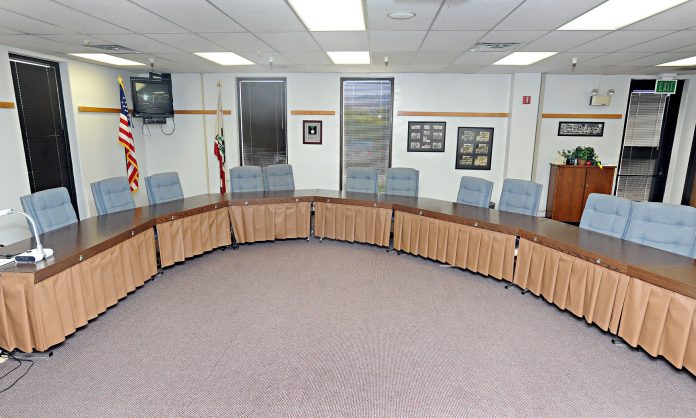How important is it for a trustee to physically be in the boardroom during proceedings, both private and public? If there are extenuating circumstances such as business travel or illness keeping them from being in attendance, is it better for the impacted trustee to remotely participate in a meeting or just let their colleagues handle the business without them?
These questions have arisen after two members of the Morgan Hill Unified School District Board of Trustees have combined for 16 teleconference calls into board meetings since June 2017.
The increased usage of such technology, where trustees listen into board proceedings on their smartphones or laptop computers from a remote location as well as comment and vote on issues, prompted district leadership to bring in an attorney to lead a discussion on “Telephonic Participation and the Brown Act” at a March 6 meeting.
“It’s totally normal, and I think it’s probably healthy given the day and age we live in,” said Board Vice President Mary Patterson when asked about it. “I’ve met with other trustees with other districts and it’s really commonplace now.”
Patterson, who has physically attended every meeting since being elected in 2016, explained that trustees must find ways to balance their demanding work schedules and/or family commitments with their duties while serving on the school board.
“I’m not sure board meeting attendance is a good marker (for being an effective trustee),” added Patterson, offering better indicators such as “getting out and talking with families and knowing the pulse of the community.”
However, Nikki Moore, staff attorney and legislative advocate with the California Newspaper Publishers Association, said while teleconferencing is permissible and not a violation of state open meetings laws, it can be seen as a way for trustees to “avoid public scrutiny” and proceedings “lose an element of our participatory democracy” when a participant is not physically present.
“There’s a lot to be said for public officials being in a public place when doing the public’s business,” Moore said.
Morgan Hill Board President Tom Arnett, whose full-time job requires regular travel, has remotely participated in seven meetings since June 2017, including four since being named chair of the board. Trustee David Gerard, who has not been present in months due to illness, has called in to nine consecutive meetings dating back to October 2017.
“It’s not ideal, but kind of the reality I have to work within,” explained Arnett, who is an education researcher for the Clayton Christensen Institute, which has him traveling across the country to visit different school classrooms. “Before stepping up as board president, I had conversations with Mary (Patterson) and (Superintendent Steve Betando) and let them know this is going to be a challenge.”
In his physical absence, Patterson, as VP, has led the meetings. However, back in December, Patterson declined a nomination for president due to her own busy schedule before taking on the vice presidency role.
“I’m perfectly comfortable with that. I knew going in Tom was going to be traveling a lot,” Patterson said. “If I am honored to be elected president next year, then I have all this experience under my belt.”
Requirements for teleconferencing
Steve Delay, President of the San Benito High School District’s Board of Trustees, said he has never seen a trustee participate via teleconference in his 12 years on the board.
“It’s a commitment to be there unless somebody is really sick or something (serious) comes up,” Delay said. “We were elected to do that job and the job is to be there.”
While Arnett has been out of the state on business when teleconferencing into meetings, Gerard has done so from his Montoya Circle residence, until he is physically able to attend. Gerard could not be reached for comment on this topic.
In either case, the trustee’s location must be open for any member of the public to come inside and listen, and comment on the public portion of the meeting. Furthermore, an agenda must be posted at the front entrance and/or outside the room where the trustee is participating. Arnett said he no individual has participated in a meeting from his remote location.
“It’s less than ideal that I can’t make it to all the meetings due to work commitments, but I think it would be unfortunate if people in my circumstance couldn’t have a place on the board,” Arnett said.
At Morgan Hill’s March 6 school board meeting, three of the seven trustees (Arnett, Gerard and Gino Borgioli) participated in both closed and public session via teleconference. During the same meeting, the board reviewed the protocols for “telephonic participation” presented by attorney Manuel Martinez of the Lozano Smith law firm.
“Questions surfaced from community members, staff and trustees about the legal and logistic parameters necessary for teleconferencing,” said Betando as to why the discussion item was placed on the agenda. “I felt that it was important to clarify what is necessary functionally and legally so that we can continue to do the business of the District with as many trustees participating as possible.”
Martinez explained that as long as a quorum (majority of board) is located within the school district boundaries, either at the board room or another location, then there is no violation of the open meetings law. One condition pertaining to closed session, where discussions are kept confidential, is making sure the trustee is alone in a secure location.
“I emphatically trust every single one of them,” said Borgioli of any inkling that a trustee would allow someone to listen in to closed session proceedings. “I have complete confidence in my board.”
Borgioli, who has never missed a meeting, has used teleconferencing twice since he was elected to the board in 2014. The first was in 2016 and the latter call-in March 6 came days after Borgioli suffered serious injuries when he was hit by a car.
If any single trustee uses the teleconference option, all votes taken at that specific meeting must be done in a “roll call” format, which means one by one each trustee must say their vote aloud so it can be properly recorded.
Trustee Donna Ruebusch has used teleconferencing three times since joining the board in 2014, while Trustees Teresa Murillo and Ron Woolf (the longest tenured member since 2010) have never utilized the teleconferencing option.
“I am sure we all can agree that there is nothing that fully replaces being in the room when it comes to group participation and effective communication,” Betando said. “We will continue to welcome and attempt to give remote access for trustee full participation as active and engaged voting members, no matter where they are in the world and no matter why they are out during board meetings.”
Trustee Absences Teleconferences
David Gerard 3 9
Tom Arnett 2 7
Donna Ruebusch 3 3
Gino Borgioli 0 2
Ron Woolf 5 0
Teresa Murillo 1 0
Mary Patterson 0 0
*Gerard, Borgioli and Ruebusch were elected to board in Nov. 2014; Arnett in June 2016; Patterson and Murillo in Nov. 2016; Woolf in Nov. 2010
There’s a lot to be said for public officials being in a public place when doing the public’s business.








